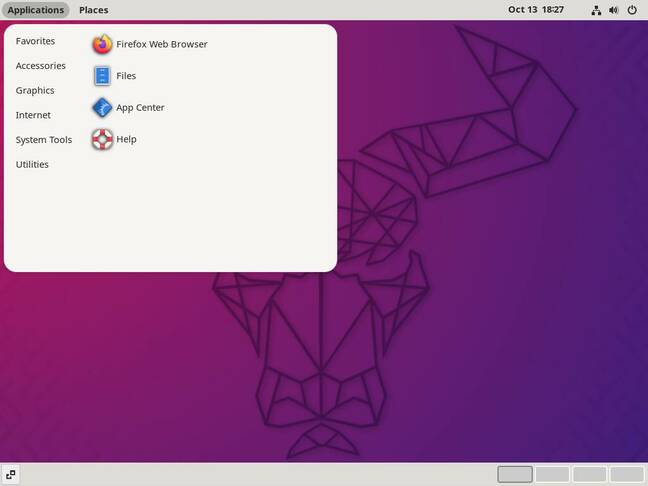The last interim Ubuntu release before next spring’s LTS is out. Some editions are seeing big changes, others very small ones.
Ubuntu 23.10 “Mantic Minotaur” appeared this week across multiple editions and ten “flavors” with different desktops. This is the last short-term or interim release before next April’s 24.04 code, which will be the next long-term support edition. Mantic has just nine months of support, so it will reach end of life just three months after the LTS.
We covered some of what’s new in this version when we looked at the new full-disk encryption and file system support in September, followed by checking out the beta version later that month. It comes with kernel 6.5.0-9, and experimental support for installing onto ZFS returns thanks to OpenZFS 2.2.0-rc3.
If you have a UEFI PC with a TPM 2 chip, you can opt for the new self-unlocking full-disk encryption system – albeit with some restrictions. This needs a snap-packaged kernel, and that doesn’t include as many driver modules, so for example it can’t handle NVMe RAID.
The standard editions are Ubuntu Desktop, based on GNOME 45, and Ubuntu Server, which also supports various non-x86 systems. For IBM kit, Server supports System Z mainframes, plus little-endian mode for POWER9 and POWER 10. Server for RISC-V supports six different single-board computers, including the new SiFive HiFive Pro P550, and the QEMU emulator. On Arm64, you get both both Server and Desktop editions for various systems including the Raspberry Pi, right up to the latest Raspberry Pi 5.

Mantic’s GNOME desktop has a new virtual-desktop indicator replacing the Activities button at top left. Click to enlarge
The primary GNOME edition comes with GNOME 45 and a Snap-packaged version of Firefox 118. This renders using Wayland by default where available, which should result in faster screen updates and some sharper images. By default, Ubuntu doesn’t install much else, because what was formerly called the Minimal Install is now the default installation. If you want the rest of the app suite, you must pick the Expanded Installation.
This provides Firefox 118, LibreOffice 7.6, and Thunderbird 115.2, shared by all the desktop flavors. Behind the scenes, there are BlueZ 5.68, Cairo 1.18, NetworkManager 1.44, Pipewire 0.3.79, Poppler 23.08, and xdg-desktop-portal 1.18. This should mean improved support for Bluetooth headphones and trackpads, among other things. Alternatively, you can select your own choice of additional applications from the new, rewritten App Center.
The release notes also flag up a few issues. The live environment you get if you choose to “Try Ubuntu” isn’t fully localized yet, so while you can use other languages, you’ll need an internet connection to use or install them.
The new Subiquity installer doesn’t support screenreaders fully as yet, so visually impaired users should opt for the version with the legacy installer for now. There may also be some issues booting from volumes formatted with XFS.

Firefox is on desktop #2, and the top-left indicator has changed to show this – and added a new dot to show that a new one is now dynamically available. Click to enlarge
As you’d expect, lots of the subsystems in Ubuntu Server received upgrades. Some are optional; for instance, Spamassasin 4 is available with DMARC support, but it’s opt-in only because it needs a newer version of Perl than is bundled with the OS. Server 23.10 comes with Docker 24.0.5, which drops AUFS and legacy overlay storage drivers. All cloud images now use a separate 1GB /boot partition.
Other upgraded components include Apache 2 version 2.4.57, Django 4.2, Dovecot 2.3.19, NginX 1.24, Containerd 1.7.2, Runc 1.1.7, Samba 4.18, ISC “Kea” DHCP 2.2.1, QEMU 8, libvirt 9.6.0, OpenLDAP 2.6.6, sssd 2.9.1 and version 2.3.3 of the monitoring plugins.
The official flavors
Some of the official remixes are little changed from the previous versions. When Ubuntu first launched, its release schedule was timed to coincide with GNOME releases – back then, GNOME 2. That means that it doesn’t sync up with the release cycles of some other desktops.
So, for instance, Kubuntu 23.10, Xubuntu 23.10 and Ubuntu Kylin 23.10 all include the same versions of their respective desktops as the previous interim releases in Ubuntu 23.04 “Lunar Lobster”.
Kubuntu Mantic has KDE 5.27.8, even though Kubuntu Lunar 23.04 also used 5.27, because KDE Plasma 6 is still in development and isn’t ready yet. Ubuntu Studio 23.10 is in turn based on Kubuntu and updates some of its extra components, too.
Xubuntu 23.10 also uses Xfce 4.18, as did Xubuntu Lunar. This is because Xfce is a rather more mature desktop, with a much slower release cycle than most of the alternatives. If you count its early, non-FOSS versions, Xfce is the oldest FOSS desktop for Linux around, predating even KDE 1 in 1998.
Xubuntu Mantic does have some new features, though. It now supports color emojis with a press of Ctrl+.. Its developers have imported a few GNOME 45 components, such as the Baobab disk-space tool, the Fonts applet, and the Simple-scan scanner app. The Greybird theme has been updated, and should better fit with the look of these newer Gtk4 applets. Like the primary GNOME edition, Xubuntu also offers a minimal version, Xubuntu Core, but in this flavor it’s a separate download.
Ubuntu MATE 23.10 is also a minor release, as the underlying MATE desktop has only put out version 1.26.2. However, several MATE components have also been updated, and it has rather nifty AI-bot generated wallpaper.
Ubuntu Unity 23.10 is another flavor that uses the same desktop as before. Coming soon, though, is an experimental new version using the [Lomiri desktop] formerly known as Unity 8. Lomiri has matured substantially recently and is now included in Debian 12, but we found it all but unusable in Debian 12. Since Ubuntu is its native environment, we’re intrigued by the prospect of a new “Ubuntu Lomiri” edition.
Ubuntu Cinnamon 23.10 has received an update too, with version 5.8.4 of both the Cinnamon desktop and the Nemo file manager. It uses version 5.8.1 of the Cinnamon screensaver; this drops the libaccountsservice module, which should fix some startup freezes. The code also includes touchegg for trackpad gesture support, and there’s a revised version of the Plymouth startup theme that fixes letters being cut-off at the bottom.
Lubuntu Mantic has received a more substantial facelift, and uses LXQt 1.3.0, which is based on Qt 5.15.10. It, and the Kubuntu remix with which it shares the Qt programming toolkit, both use KDE’s Discover app store instead of Canonical’s Flutter-based App Center. One advantage of this is that it’s easy to add support for Flatpak packages.
The newly reinvigorated Edubuntu 23.10 also has had a makeover. It adds some more GNOME accessories from the underlying GNOME flavor, but also adds some new educational apps, such as OpenBoard, Mnemosyne, and ConvertAll. As teenaged BASIC programmers ourselves, we’re also happy to hear that it now includes the educational dialect Basic-256.
One of the editions that’s seen the most changes is Ubuntu Budgie 23.10. This flavor’s release notes reveal significant changes.
This release uses Budgie 10.8, and includes Magpie 0.9, a fork of GNOME 43’s Mutter. As we reported earlier today, GNOME is planning to drop support for X11 soon. Apparently, Mutter 11 supports X11 better than Mutter 12, as used in GNOME 44. In future, this version 0.x Magpie will be replaced by Magpie 1, which will be based on wlroots to improve its Wayland support.
The new Budgie flavor adopts the Status Notifier spec for its system tray, along some parts of the GNOME 45 stack and version 1.7 of the Budgie extras. Its search tool was ported from Vala to C for better international language handling, and is faster too.

If you don’t care for GNOME Shell, just install the `gnome-shell-extensions` package and the login menu gains the retro-style GNOME Classic. Click to enlarge
Stop the (metaphorical) press
Very soon after release, the downloads for the GNOME and Budgie editions were removed again.
Like many FOSS projects, Ubuntu crowd-sources translations into many languages, and at the last minute, someone sabotaged the Ukrainian language translation by inserting some rather unpleasant messages about both sides in the current conflict in Israel and Palestine.
“We believe that the incident only impacts translations presented to a user during installation through the Live CD environment (not an upgrade),” Ubuntu said. “During installation the translations are resident in memory only and are not propagated to the disk. If you have upgraded to Ubuntu Desktop 23.10 from a previous release, then you are not affected by this issue.”
The ISO that uses the legacy installer is still available, as are the various other flavors which were not affected. Upgrading existing installations works fine, too.
One noticeable difference that makes a couple of the flavors stand out is that, like the main GNOME-based Desktop edition, both Ubuntu Budgie and Ubuntu MATE offer editions for the Raspberry Pi – in this case, the Pi 4 (with 2GB or more of RAM) the and Pi 400. ®












